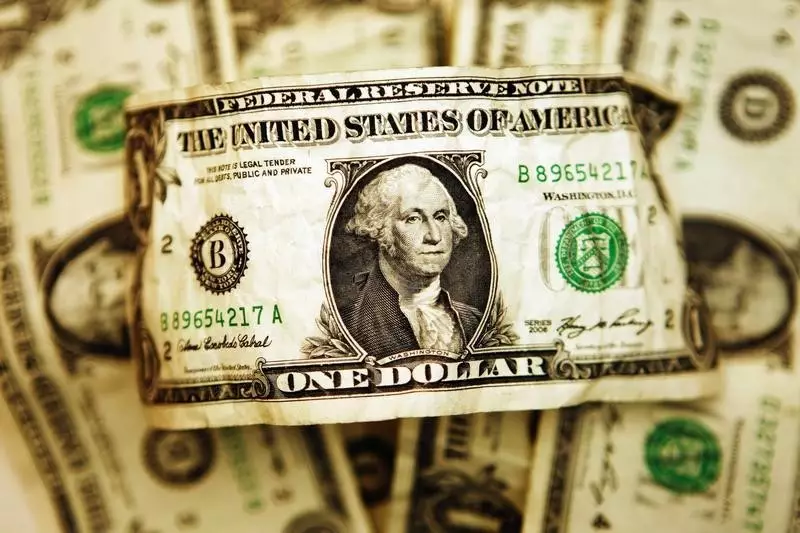The U.S. dollar, a pivotal currency in global finance, recently experienced a minor decline, slipping from a six-week peak as traders brace for a significant employment report that could shape the economic landscape leading up to the Federal Reserve’s next policy meeting. This downward shift, occurring at 04:25 ET, saw the Dollar Index—an indicator that measures the dollar’s strength against a basket of six other currencies—retract by 0.1% to a value of 101.667. Despite this pullback, the index has enjoyed a robust week, increasing nearly 1.5%, marking its best performance since April.
The dollar’s recent ascent has been largely fueled by a mix of favorable labor data and heightened safe-haven demand amidst escalating tensions in the Middle East. Key indicators such as job openings, private payroll data from ADP, and weekly jobless claims have hinted at an economically resilient U.S. labor market. These developments come at a critical time when investors are evaluating the potential ramifications of geopolitical unrest on economic stability.
Looking to the near future, all eyes are now set on the upcoming September non-farm payrolls report. This critical release is anticipated to shape expectations regarding further interest rate adjustments by the Federal Reserve. Economists predict a steady pace of job growth in the final month of Q3, forecasting an increase of approximately 147,000 payrolls while the unemployment rate remains steady at 4.2%. Contrastingly, analysts from ING express a more cautious outlook, projecting a lower payroll increase of 115,000 and a slight rise in the unemployment rate to 4.3%.
Despite varying predictions, the prevailing sentiment remains focused on the Federal Reserve’s monetary policy trajectory. Analysts suggest that the anticipated job report is unlikely to significantly alter the Fed’s plans, with expectations leaning towards a 25 basis point cut in interest rates come November. Although there have been signs of a hawkish shift in the dollar’s outlook, particularly in response to economic data releases this week, a weaker jobs report could lead to a recalibration of the dollar’s value moving forward.
In Europe, the euro has also reflected economic pressures, with EUR/USD steadily declining to 1.1027. Over the past week, the euro has decreased by more than 1% amidst signs of softening inflation in the Eurozone, which have overshadowed positive economic activity indicators, including increases in French industrial production. The European Central Bank, responding to these inflationary trends, has begun to lower interest rates. Additionally, influential ECB policymaker Isabel Schnabel has adopted a more dovish stance in recent discussions.
Market analysts predict a continued bearish bias for EUR/USD in the short term, despite expectations of a slight uptick in U.S. unemployment, which could provide temporary relief. The combined factors of less favorable interest rate differentials, a fragile risk sentiment environment, and concerns surrounding a tumultuous EU budget season suggest that EUR/USD could struggle to maintain stability. Notably, the 1.1000 level is recognized as a significant support point, with a breach below this threshold potentially accelerating a decline toward 1.09.
On the other side of the Atlantic, GBP/USD made a modest recovery, rising by 0.2% to 1.3154 after a sharp drop of 1% on Thursday. This decline followed comments from the Bank of England Governor, Andrew Bailey, signaling the possibility of aggressive rate cuts in response to diminishing inflation pressures. Despite the recent fluctuation, the British pound remains on an upward trajectory, having risen over 3% this year, fueled by expectations that the Bank of England may maintain elevated interest rates longer than the Federal Reserve.
Meanwhile, USD/JPY witnessed a decrease of 0.4% to reach 146.28 after previously hitting a six-week peak. The uncertainty surrounding the future of monetary policy from the Bank of Japan continues to add complexity to currency valuations. In contrast, the USD/CNY pair remained stable at 7.0185, with Chinese markets on hiatus due to the Golden Week celebrations, illustrating the diverse factors at play in the global currency market.
The interplay of job data, interest rates, and geopolitical tensions continues to shape market dynamics and currency valuations, particularly for the U.S. dollar. As investors anticipate upcoming economic signals, the influence of these factors on the broader financial landscape remains an area of keen observation and analysis.


Leave a Reply